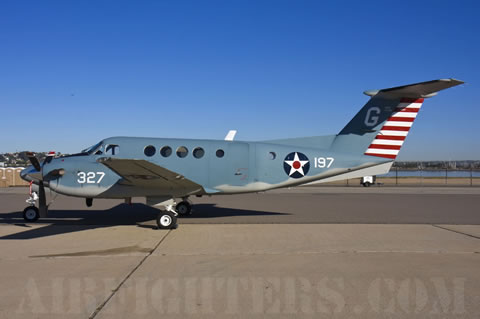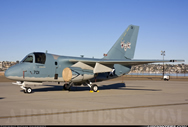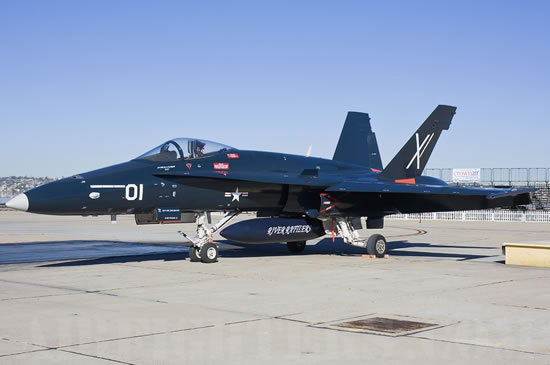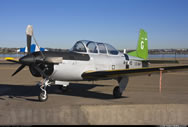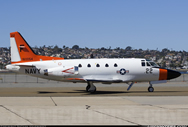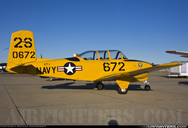
This year is the "Centennial of Naval Aviation" and a year-long celebration is planned to honor the occasion (including the Navy, the Marine Corps and the Coast Guard) and its aviators. The 34 events which run from February to December started with the San Diego Centennial Kick-off Celebration and Aerial Review on February 10-12th. The events are designed to raise public awareness of Navy, Marine Corps, Coast Guard and NASA aviation operations and commemorate 100 years of Naval Aviation across the world.

Wearing three tone blue/blue/white of a F-U Corsair of Air Group 85 "Sky Pirates" aboard the USS Shangri-La (CV 34) circa 1944.
Today's arresting gear can easily be traced back to Ely's design and even the canvas awnings he placed at the front and sides of the ship can be seen in modern safety barrier systems. However, little else in today's Navy bears any resemblance to the equipment used on the first flights. While the latest CVN, USS George H.W. Bush is technologically far from the USS Birmingham, many would say that the field of aviation has advanced further in the past 100 years than any other. From the Wright brothers' first flight on December 17th 1903 in Kitty Hawk, North Carolina, to Neil Armstrong's (a former naval aviator) first step on the moon at 2:56 UTC July 21st 1969, can only be described as a miraculous achievement for a 63-year period. Since Ely's flight in 1911 the US Navy has been pushing the boundaries of aviation and space exploration. For example the first trans-Atlantic crossing by air was by US Navy NC-4 flying boat on May 27th 1919 and the first US astronaut to orbit the earth was USMC pilot LTCOL John H. Glenn, Jr..
The US Navy could not have picked a more fitting place for the Centennial kick-off than San Diego. Officially recognized as the "Birthplace of Naval Aviation" by a resolution of the House Armed Services Committee on August 15th 1963, Naval Air Station North Island (known as Naval Air Station, San Diego until 1955) was commissioned in 1917. Prior to this many Naval aviators, including Lieutenant Ellyson, the first US Naval aviator, were trained at the uninhabited sand flat known as North Island. North Island has seen many aviation milestones over the past 100 years including, the first seaplane flight (1911), the first parachute jump in the San Diego area (Tiny Broadwick, 1914) as well as the first mid-air refueling and the first non-stop transcontinental flight (both 1923). On May 9th 1927 Charles A. Lindbergh departed North Island on his first leg of his world famous transatlantic journey from New York to Paris. His aircraft, The Spirit of St. Louis, was built in San Diego and the city's commercial airport now bears his name.
In 1928 the "Sea Hawk" demonstration team of VF-6B ("Felix the Cat") squadron showed the skills obtained by Navy pilots and often flew in formation with their wings tethered together! Today's US Navy demonstration team the "Blue Angels" wow crowds just as their predecessors did but fortunately for current pilots close formation doesn't require a physical tether!
Naval Air Station San Diego also became the home port of the Navy's first aircraft carrier, the USS Langley, in 1924. This started San Diego's continuous role as the home port for Pacific Fleet carriers. Amazingly by 1935 North Island was the home to all four of the Navy's carriers, the USS Langley, USS Lexington, USS Saratoga and USS Ranger. In 1948 North Island became home to the Navy's first jet training squadron, VF-52 which flew the Lockheed TV-2 "Shooting Star" (T-33). Other jet-age firsts for North Island include the first S-3 "Viking" squadron stood up in 1974 and HSL-41 became the first squadron to receive both the Sikorsky SH-60B and MH-60R.
With such a historic place for the Centennial of Naval Aviation Kick-off event what better way to celebrate US Naval aviation than to try and assemble an example of all surviving Navy aircraft. More than 70 historic and current Navy, Marine and Coast Guard aircraft were scheduled to be on static display (see Appendix 1). Among these static aircraft are several that have been specially painted in heritage schemes to create a living history of as many eras of Naval aviation as possible. Originally 18 aircraft had been chosen to participate, nine from the fleet and nine from training command, however the schemes have been so popular that it is likely the finally number will be closer to 30. Below is a table of the planned heritage schemes.
| Aircraft Type | BuNo | Assignment | Scheme |
|---|---|---|---|
| EA-6B | 160609 | VAQ-129 | USS Coral Sea Air group markings |
| E/A-18G | 166899 | VAQ-129 | F-U Corsair of Air Group 85 "Sky Pirates" aboard the USS Shangri-La (CV 34) circa 1944 (three tone blue/blue/white) |
| F/A-18A | TBD | VX-31 | Heritage China Lake Test Scheme |
| F/A-18A+ | 162866 | VFA-204 | Navy Reserve aircraft circa 1950 |
| F/A-18C | 163745 | VFA-106 | F6F-5 Bomber-Fighter Squadron Seventeen (VBF-17) on USS Hornet (CV-12) circa 1945 |
| F/A-18C | 163733 | VFA-122 | WWII three tone blue/blue/white |
| F/A-18C | 164673 | VFC-12 | WWII Gloss Sea Blue |
| F/A-18E | 165666 | VFA-106 | VA-106 squadron Skyhawk on USS Forrestal (CVA-59) circa 1967 Vietnam War |
| F/A-18F | 165677 | VFA-122 | Current Navy Working Uniform scheme |
| P-3C | 161591 | PATWING 11 | PBY-5a (44-P-5) "Strawberry 5", VP-44 "Golden Pelican", which located the Japanese Fleet prior to the Battle of Midway |
| P-3C | 160770 | PATWING 2 | Seaplane Gray/White |
| P-3C | 158206 | PATWING 10 | Black/White EP-3B RoCAF circa 1969 Vietnam |
| S-3B | 160581 | VX-30 | Early WWII tactical paint scheme circa 1942 (Battle of Midway) |
| T-6A | 165966 | TW-6 | Gloss Sea Blue |
| T-6B | 166064 | TW-5 | 1930 - 1950 Standard yellow primary trainer scheme |
| TC-12B | 161197 | TW-4 (VT-35) | Early WWII tactical paint scheme circa 1942 (Battle of the Coral Sea) |
| T-34C | 161841 | TW-4 | Ranger Air Group (CV 4) assigned aircraft circa 1938 |
| T-34C | 164169 | TW-5 | Standard paint scheme for Coast Guard aircraft circa 1936 |
| T-34C | 164172 | TW-5 | Standard paint scheme for Marine Corps aircraft circa 1938 |
| T-39N | 165523 | TW-6 | Enterprise Air Group (CV 6) assigned aircraft circa 1938 |
| T-44A | 160984 | TW-4 | Represents the NC-4, the first aircraft to fly across the Atlantic Ocean |
| T-45C | 165598 | TW-1 | Enterprise Air Group (CV 6) assigned aircraft circa 1939 |
| T-45C | 163656 | TW-2 | Wasp Air Group (CV 7) assigned aircraft circa 1939 |
| T-45C | 167100 | TW-2 | Centennial Scheme |
| HH-60H | 163787 | HSC-84 | Light Attack Helicopter Squadron 3 (HAL-3), Vietnam War |
| MH-60S | 166323 | HSC-3 | Aircraft of Lt. (j.g). John Thornton (Navy Cross) HU-2 circa 1950 |
| MH-60S | 166294 | HSC-2 | Aircraft of Lt. (j.g). John Thornton (Navy Cross) HU-2 circa 1950 |
| MH-60R | 166524 | HSM-41 | Night Air Group 90 aboard the USS Enterprise (CV 6) circa 1944 (three tone blue/blue/white) |
| TH-57 | 162064 | TW-5 | White with earliest standard naval insignia (anchor 1914) |
| UH-1N | 158270 | HMLAT-303 | Aircraft of Maj. Pless, USMC (Medal of Honor), VMO-6 "Tomcats" circa 1967 Vietnam War |
The man behind the heritage scheme and historian for the Centennial of Naval Aviation is Capt. Rich Dann. Based at North Island, Dann, a helicopter pilot, has spent the last year liaising with squadrons across the country regarding the heritage paint schemes. When asked how much input individual squadrons had on the designs he replied: "There was some to and fro. I supplied the basic designs and then some squadrons would ask for slight changes, such as, could they have the squadron name here etc.". He points out that all aircraft painted were due for new paint at this time and will carry these schemes until they are scheduled for their next painting, so no extra costs were involved. His poignant statement: "The Prowler (E/A-6B) will probably go to the bone yard or a museum wearing this heritage scheme." shows just how significant this living history is, so let's hope it goes to a museum for future generations to enjoy!
As well as being able to view the static aircraft the public was also invited to tour three currently serving US Navy ships, the USS Peleliu (LHA 5), USS Pinckney (DDG 91) and the USS John C Stennis (CVN 74).
The USS Peleliu is an LHA Amphibious Assault Ship launched in November 1978. She is named in honor of the 3rd Amphibious Force's assault and capture of Peleliu Island in the fall of 1944. She has taken part in both Operation Enduring Freedom and Operation Iraqi Freedom and has recently undergone refits to the flight deck and superstructure to prepare for the arrival of the MV-22 "Osprey" on board.
The USS Pinckney is the 41st of the Arleigh Burke class of guided-missile destroyers. She is named after Navy Cook First Class William Pinckney who won the Navy Cross for his courageous rescue of a fellow crew member when an enemy bomb struck the USS Enterprise (CV 6) on October 26th 1942. Pinckney was one of only four African Americans to receive the Navy Cross in World War II and the last to have a ship named after him.
The USS John C Stennis was commissioned on December 9th 1995 at Naval Station Norfolk, VA and was named in honor of Senator John Cornelius Stennis (D-Mississippi) who served in the Senate from 1947 to 1989. She hosted the first carrier landing of an F/A-18E/F Super Hornet on January 18th 1997. Leaving Norfolk on March 7th 1998 the Stennis sailed on her maiden deployment to the Persian Gulf. Five months later she left for her new homeport of North Island, CA. She has taken part in Operations Southern Watch and Enduring Freedom, as well as major exercises around the world. The Stennis is home to the many squadrons that make up Carrier Air Wing 9, (VFA-14 "Tophatters", VFA-41 "Black Aces", VFA-97 "Warhawks", VFA-192 "Golden Dragons", VAQ-133 "Wizards", VAW-112 "Golden Hawks", HSC-8 "Eight-Ballers", HSM-71 "Raptors" and VRC-30 "Providers").
To keep the public entertained during the day a series of activities were arranged including demonstrations of the Curtiss A-1 Triad, the very first US Navy Aircraft, motorcycle stunt shows, a classic car show, entertainers, live music and several parachute displays by the US Navy Leap Frogs.
However, the main attraction of the event was the parade of flight. Composed of 190 aircraft spanning the entire century of Naval Aviation this is the largest ever gathering of its kind. Led by the Blue Angels the parade was due to feature approximately 30 historic warbirds including the STM Ryan, N3N Canary, N2S Stearman, SNJ Texan, SNB Kansan, FM-2 Wildcat, F6F Hellcat, F8F Bearcat, F4U Corsair, TBM Avenger, SBD Dauntless, PV-2 Harpoon, SB2C Helldiver, HU-16 Albatross, Four T-28 Trojans, Four T-34B Mentors, A-1 Skyraider, FJ-4 Fury, T-2 Buckeye, and T-33B Shooting Star. One hundred and sixty current inventory aircraft were scheduled to take part with the finale being a 30-plane formation fly-by from Carrier Air Wing 9 of the USS John C Stennis Carrier Strike Group.
 The parade of flight began with a parachute drop by the US Navy Leap Frogs from a MH-60 Knight Hawk helicopter on to the deck of the USS Stennis. With only a handful of 'no shows' the stream of aircraft continued for more than two hours, with only short gaps with no activity. The warbirds staged out of Brown Field and flew by in chronological order starting with the Ryan. With the modern aircraft staging from MCAS Miramar the Marine presence could easily be seen and their extended demonstration involving all aircraft types stole the show for many. Short displays by the A/V-8 Harrier and V-22 Osprey took place in front of the VIPs on board the USS Stennis before a CH-46 Sea Knight hovered low over the water for a swimmer to exit in to the bay. Enter the US Coast Guard with their HH-60J Jayhawk helicopter to rescue the swimmer and show their talents in such activities.
The parade of flight began with a parachute drop by the US Navy Leap Frogs from a MH-60 Knight Hawk helicopter on to the deck of the USS Stennis. With only a handful of 'no shows' the stream of aircraft continued for more than two hours, with only short gaps with no activity. The warbirds staged out of Brown Field and flew by in chronological order starting with the Ryan. With the modern aircraft staging from MCAS Miramar the Marine presence could easily be seen and their extended demonstration involving all aircraft types stole the show for many. Short displays by the A/V-8 Harrier and V-22 Osprey took place in front of the VIPs on board the USS Stennis before a CH-46 Sea Knight hovered low over the water for a swimmer to exit in to the bay. Enter the US Coast Guard with their HH-60J Jayhawk helicopter to rescue the swimmer and show their talents in such activities.
Back in the air and the parade of flight continued with the modern US Navy aircraft, including some of the less well known models such as the C-9, C-20 and E-6. Then out of the sun came the mass formation of 35 CVW-9 aircraft. Impressive to see is an understatement, the amount of air power on display gave the crowd a glimpse of the might of a single US Navy Carrier Air Wing. The single pass over head signaled the end of the flying portion of this kick-off event.
With historical and current US Naval aviation well represented what of the future? The F/A-18 Hornet will be around for many years to come, with the newer E and F model Super Hornets serving with front line squadrons and the E/A-18G Growler electronic warfare platform steadily replacing the venerable Prowlers. The next generation Navy fighter the F-35 Joint Strike Fighter is known to many because of its well-publicized issues and delays, and its absence from such a historic event can only be pondered. It is still undergoing stringent flight tests at NAS Patuxent River but many were surprised that not even a mock-up was on display.
What was shown as the future of Naval Aviation were three unmanned aerial vehicles (UAV). The Global Hawk surveillance aircraft has been in the US Navy's inventory since 2006 and in 2008 the Navy awarded a billion plus contract to Northrop Grumman for more Global Hawks. The Northrop Grumman MQ-8 Fire Scout is an unmanned reconnaissance helicopter. In 2010 an MQ-8B was involved in a drug interdiction in the Eastern Pacific Ocean when it was on a test flight from the USS McInerney. The final UAV on display was a mock-up of the X-47B Unmanned Combat Aerial System (UCAS). With its first flight happening a week before the kick-off event, on February 4th 2011, this really is the fore-front of Naval aviation. The mock-up showed features that are not present on any other UAV, an in-flight refueling probe and a tail hook for carrier landings. Originally planned for 2011, carrier test landings will now take place during 2013 during stage two of development.
As mentioned earlier, the field of aviation has changed so drastically over the past 100 years that it is hard to imagine where we will be 100 years from now. What we do know is that the US Navy and its service men and women will be spearheading developments and helping to lead it in to the next century.
Appendix 1. Static Displays
| 1. C-130 Hercules | 27. EA-6 Prowler (no show) | 53. F4U Corsair |
| 2. V-22 Osprey | 28. AV-8 Harrier | 54. N3N Canary |
| 3. C-40 Clipper | 29. F/A-18 Hornet | 55. N2S Stearman |
| 4. CP-140 Aurora | 30. F/A-18 Hornet | 56. SN J Texan |
| 5. P-3 Orion | 31. EA-18 Growler | 57. TBM Avenger |
| 6. EP-3 ARIES | 32. F/A-18 Hornet | 58. PB4Y-2 Privateer |
| 7. E-6 Mercury | 33. CH-46 Sea Knight | 59. PV-2 Harpoon |
| 8. C-20 Gulfstream III (no show) | 34. MH-60 Knight Hawk | 60. UCAS X-47B |
| 9. C-12 Huron | 35. MH-60 Knight Hawk | 61. Global Hawk |
| 10. T-45 Goshawk | 36. HH-60 Rescue Hawk | 62. Fire Scout |
| 11. T-45 Goshawk | 37. SH-60 Sea Hawk | 63. JN-4H Jenny |
| 12. E-2 Hawkeye | 38. C-2 Greyhound | 64. TD2C-1 Culver |
| 13. T-44 Pegasus | 39. T-34 Mentor | 65. A-1 Triad |
| 14. F-5 Tiger | 40. MH-60 Knight Hawk | 66. A-6 Intruder (no show) |
| 15. F-16 Falcon | 41. OV-10 Bronco | 67. A-7 Corsair II (no show) |
| 16. T-39 Sabreliner | 42. TA-4 Skyhawk | 68. OY-1 Sentinel |
| 17. T-6 Texan II | 43. T-34 Mentor | 69. HOK Huskie |
| 18. TH-57 Sea Ranger | 44. T-28 Trojan | 70. H-19 Chickasaw |
| 19. T-34 Mentor | 45. HUP Helo | 71. F/A-18 Hornet |
| 20. T-34 Mentor | 46. HU-16 Albatross | 72. T-38 Talon |
| 21. TC-12 Huron | 47. STM Ryan (no show) | 73. UAV |
| 22. F-14 Tomcat (no show) | 48. UH-1B Huey | 74. F/A-18 Hornet |
| 23. S-3 Viking | 49. TBM Avenger | 75. F/A-18 Hornet |
| 24. FA-18 Hornet | 50. SN J Texan | 76. T-6 Texan II |
| 25. HU-25 Guardian | 51. SN J Texan | 77. VC-143 Challenger (no show) |
| 26. EA-6 Prowler | 52. SN B Kansan | 78. F-5 Tiger |











